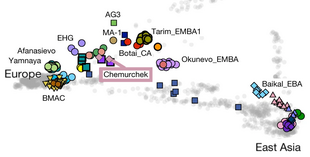46°07′41″N 91°41′14″E / 46.128186°N 91.687306°E
Chemurchek culture and contemporary cultures and polities circa 2000 BCE.[1][2][3][4] Chemurchek statues have also been found on the northern slopes of the eastern Tian Shan.[5] | |
| Geographical range | South Siberia |
|---|---|
| Dates | 2750-1900 BCE.[7] |
| Preceded by | Afanasievo culture |
| Followed by | Munkhkhairkhan culture Sagsai culture Deer stones culture Subeshi culture |

The Chemurchek culture (Ch:切木尔切克, Qièmùěrqièkè; Ru: Чемурчекская культура), also called Khemtseg, Hemtseg, Qiemu’erqieke, Shamirshak (2750-1900 BCE), is a Bronze Age archaeological culture of western Mongolia and the borders of neighbouring countries, such as the Dzungarian Basin of Xinjiang and eastern Kazakhstan.[7] It immediately follows the Afanasievo culture, and is contemporary with the early Tarim Mummies to the south and the Okunev culture to the north.[9] The Chemurchek burials are characterized by large rectangular stone fences, built around collective tombs. The mortuary position of the deceased (supine position with flexed legs) is similar to that of the Afanasievo culture, but the Chemurchek culture is considered as distinct. The name "Chemurchek culture" is derived from the Chemurchek cemetery[10] in Altay City of Chinese Xinjiang.[11] Chemurchek sites have been identified from western Mongolia to areas as far west as the Ili valley (Bortala Mongol Autonomous Prefecture).[12]
- ^ Zhang et al. 2021.
- ^ Kovalev 2022, p. 769, Fig.1.
- ^ Bobrov, Vladimir (January 2021). "Shigir idol: Origin of monumental sculpture and ideas about the ways of preservation of the representational tradition". Quaternary International. 573: Fig. 1. doi:10.1016/j.quaint.2020.08.041.
- ^ Chen, Kwang-tzuu; Hiebert, Fredrik T. (June 1995). "The Late Prehistory of Xinjiang in Relation to Its Neighbors". Journal of World Prehistory. 9 (2): 271.
While this culture is known primarily from the excavations at Ke'ermuqi, many such burials are known in the Altai foothills, for example, in the counties of Habahe, Jimunai, and Bu'erqin (IAX, 1981a) and new excavations have been initiated in this region. The distribution of Ke'ermuqi type burials indicates that they are widespread along the foothills of the Zhunge'er Basin but are not found across the Tianshan Mountains. In western Zhunge'er, Ke'ermuqi type tombs have been identified at the site of A'erkate in the Yili Valley (Li Yuchun, 1962) and at the sites of Adongquelu and Aershate near Wenquan (Li, 1988). The Ke'ermuqi culture extended to the southern parts of the Zhunge'er Basin with burials found near Ulumuqi (Wang Mingzhe, 1984; IAX, 1985b, pi. 148) and near Mulei (Huang and Dai, 1986). Also, a Ke'ermuqi-style gray incised round-bottomed jar was found at Kan'erzi, in Qitai County (CCQ, 1982), in the region of the Yanbulake] eastern Xinjiang oasis cultures.
- ^ Kovalev 2022, p. 771.
- ^ Kovalev 2012, p. 124, statue 55.
- ^ a b Jeong et al. 2020.
- ^ Zhang, Fan; Ning, Chao; Scott, Ashley (November 2021). "The genomic origins of the Bronze Age Tarim Basin mummies". Nature. 599 (7884): 256–261. Bibcode:2021Natur.599..256Z. doi:10.1038/s41586-021-04052-7. ISSN 1476-4687. PMC 8580821. PMID 34707286.
- ^ Gantulga, Jamiyan-Ombo (21 November 2020). "Ties between steppe and peninsula: Comparative perspective of the Bronze and Early Iron Ages of Мongolia and Кorea". Proceedings of the Mongolian Academy of Sciences: 65–88. doi:10.5564/pmas.v60i4.1507. ISSN 2312-2994.
- ^ 47°46′50″N 87°51′36″E / 47.780636°N 87.860069°E
- ^ Museum notice
- ^ Cite error: The named reference
KTCwas invoked but never defined (see the help page).

